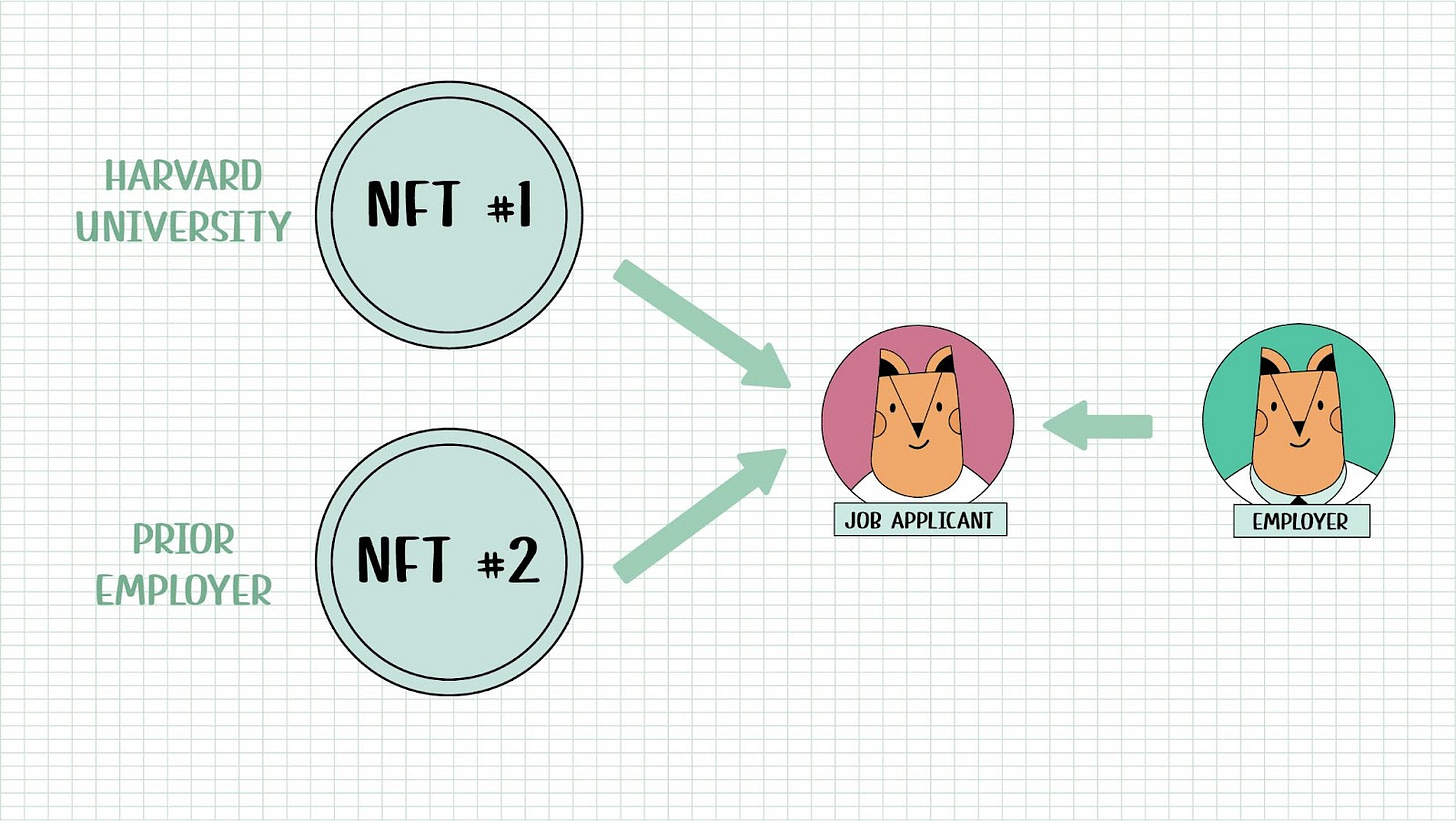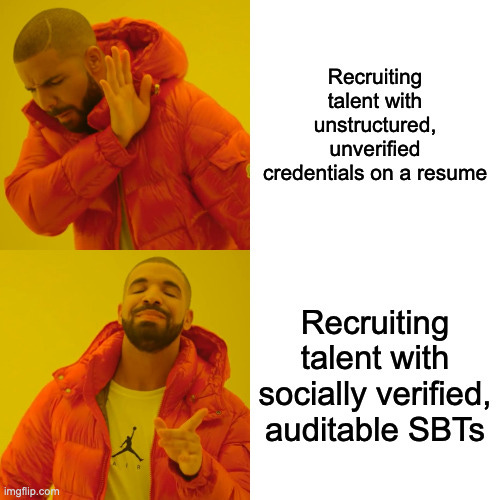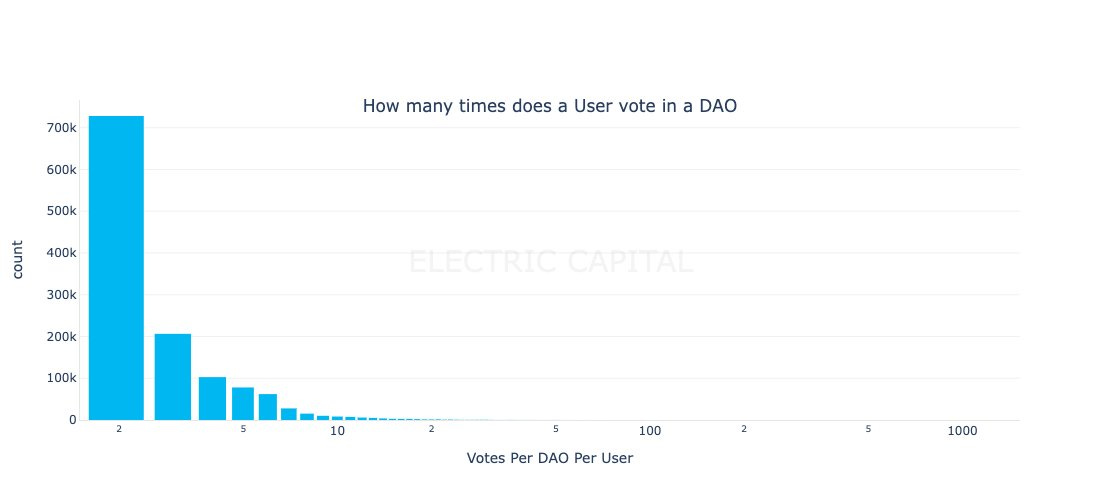NoDW #5: SBTs and DAOs
The Newsletter of Decentralized Work: Data-driven insights on the world of decentralized work
Curated by the talentDAO community. Complied by ItamarGo
In this edition:
Our feature article: Soulbound Tokens and Managing Talent in DAOs
From the talentDAO community
Elsewhere in Web3
Bonus morsels
Soulbound Tokens and Managing Talent in DAOs
Early Ideas From Weyl, Ohlhaver, & Buterin (2022)
By: Nemo
Organizations are nothing without their talent. Without talent, organizations can’t cast a vision, set a strategy, develop tactics, track goals, learn, grow, innovate, or adapt. Without acquiring, deploying, equipping, and rewarding the right talent at the right time, organizations die. Talent acquisition, planning, deployment, training, motivation, and rewards make up the modern, strategic talent management functions many of us are familiar with. While it’s likely that most of us understand, at least in theory, how performing these functions well leads to organizational success, it’s unlikely that most of us have ever stopped to ask “what is talent?”
What is talent? What makes it a uniquely challenging resource to manage?
Put simply, talent is an individual’s summed capabilities that are used to achieve organizational goals1. Capability is an umbrella term for the human knowledge, skills, abilities, values, interests, personality traits, and other characteristics required to perform tasks. Not only are these capabilities a significant source of competitive advantage and collective power when accessed by an organization, they are also notoriously hard to measure, retain, and change. Organizational scientists describe talent as a resource with unique challenges related to its intangibility (i.e., measurement difficulty), mobility (i.e., possibility of leaving the organization, and malleability (i.e., ever-changing nature). However, organizations that can make their talent more tangible through better capability measurement, intentionally guide their talent mobility towards or away from the right places, and proactively shape their talent in ways that help achieve goals, will massively increase their chances of surviving and thriving.
How does talent management in DAOs further complicate these challenges?
Decentralized autonomous organizations (DAOs) are novel human collaboration structures where the unique characteristics of talent as an advantageous resource are amped up. DAOs’ talent intangibility is maximized through pseudo-anonymity of contributors, talent mobility is maximized through lower barriers to entry and exit, and talent malleability is harder to achieve through decentralized governance. DAOs may benefit in the end from maximizing these unique resource characteristics. Still, it places additional pressure on teams and individuals who need to establish trust, build low-friction collaboration networks, and improve information sharing to form healthy and productive working relationships.
What are SBTs? How could they address talent management challenges in DAOs?
Weyl, Ohlhaver, & Buterin (2022) recently introduced soulbound tokens (SBTs): non-transferable tokens that act as primitives of “social identity.” Like a web3 resume, these primitives represent credentials and capabilities similar to those conferred by legacy, third-party organizations and inferred by experiences. But, instead of relying on the record-keeping of third-party organizations or emotional impressions of inferred capabilities from “self-certified” experiences2, SBTs can be socially certified by other SBT-holding accounts, or Souls, either organizations or individuals. These attestations build social proofs for Souls through the reputation assignment of the network. In addition, Souls are publicly visible, non-transferable, and traceable, conferring unique benefits to helping DAOs make their talent resources more tangible, less adversely mobile, and intentionally malleable. Although the full implications noted in Weyl et al.’s paper, the pros and cons of the technical possibilities and limitations, and the larger goal of contributing to a decentralized society (DeSoc) are out of the scope of this essay, here are three practical applications for how SBTs might benefit talent management in DAOs:
1. SBTs could make better talent screening and onboarding possible
SBTs provide networked credentials that are native to web3’s digital infrastructure, but Weyl et al. note that “the true power of this mechanism emerges when SBTs held by one Soul can be issued—or attested—by other Souls, who are counterparties to these relationships” (p. 2). SBTs add “social provenance” to credentials in ways that increase their credibility and value in the eyes of decision-makers. You might argue that this social attestation is similar to a skill endorsement on LinkedIn, but rather than a centrally controlled endorsement of a generic skill label, SBT-encoded credentials come from experiences with more social cachet from organizations and individuals. These are also inherently more quantifiable and demonstrable than qualitative “Recommendations,” allowing for scalable qualification screening for talent acquisition or onboarding. On top of this, programmatically screening SBTs could be an auditable process, as the authors say, “...mak[ing] discrimination more transparent and therefore potentially contestable” (p. 11).
Traditional organizations must gatekeep organizational membership via talent screening as resources and opportunities are scarce. However, DAOs democratize access to work by allowing contributors to organically opt-in to projects and teams. DAOs also democratize access to rewards through peer-based voting and bounties. Democratizing work and rewards place a greater need on proper talent onboarding and deployment. Anecdotally, in talentDAO, some self-screening occurs through community observers deciding to become community contributors voluntarily. Yet, we often struggle to manually classify new contributor capabilities and interests and match them to opportunities. DAOs equipped with SBT credentials could automate this onboarding process (and, in some cases, the screening process) to better match capabilities with needs.
2. SBTs could increase the discoverability of talent
SBTs’ publicity could provide opportunities for credible, open-source talent databases that developers use to build apps recruiters access and search. Sourcing talent via LinkedIn has become de rigeur for many recruiters as LinkedIn provides an accessible, searchable talent database. But LinkedIn’s centrally controlled and gated database prevents disadvantaged and underrecognized talent from being discovered and can often lead to incentive feedback loops where the same individuals are capturing most of the attention.
Weyl et al. note that “an ecosystem of SBTs could unlock a censorship-resistant, bottom-up alternative to top-down commercial and “social” credit systems” (p. 4). An ecosystem of apps that can search credentials magnifies the network effects of individuals connecting to communities that distribute SBTs. This creates virtuous cycles where the credibility of these credentials increases, which increases searchability for in-demand, previously undiscoverable talent. At the moment, DAOs have an easy time attracting and retaining talent as awareness and interest among potential contributors climbs. But, as the number of DAOs increases talent becomes scarcer and DAOs will have to turn to active recruiting tools that facilitate strong talent sourcing.
3. SBTs could connect education investments to talent gaps
When comparing SBTs to the credentials and reputation inferred by legacy organizations, Weyl et al. state, “[legacy] systems are wildly inefficient and do not lend themselves to composability or computation for rapid, efficient coordination” (p. 25). Part of legacy organizations’ inability to “rapidly coordinate” manifests in a failure to match education and training with actual talent needs in the market. SBTs help solve this problem by providing an accessible, searchable database of existing capabilities along with data on which capabilities organizations are competing for. These are strong signals for educational institutions and training organizations (whether DAOs or traditional organizations) to guide their offerings and materials.
In addition, DAOs that share talent development needs across a network of decentralized teams may struggle to identify capability gaps or invest in upskilling or reskilling that yields results. Accessible, searchable data on available human capabilities may provide evidence-based reasons for where and how to invest in training and development. Instead of DAOs skipping education investments or firing training resources randomly from a proverbial shotgun, SBTs allow both training content creators and consumers to be more targeted in who, where, and how they upskill.
Where do we go from here?
The three points above paint a very rosy picture of how SBTs can help DAOs overcome unique talent management challenges and make better talent investments. However, as Weyl et al. acknowledge, several limitations and open questions still need to be addressed and answered. Namely, the challenges of dealing with ‘too much publicity’ of various credentials and experiences. Will SBTs and talent acquisition or management systems create incentives that lead to people gaming the system by adding quantity over quality? How will users manage what is publicly visible versus private? Weyl et al. also mentioned ways that users could cheat the system by accessing communities superficially without any watchdog entity to verify whether membership is legitimate.
Weyl et al. describe several responses to these and other challenges; it’s very likely that some historical or biographical information will be privately stored off-chain, while some will be stored publicly on-chain. And in the future, there will still be a place for traditional screening and selection tools such as assessments to provide proficiency measurements.
The exciting vision for the future is the possibility of how social proof will affect the signal gathering that usually happens as people are joining, assimilating, and developing within organizations. And how other traditional diagnostic tools such as surveys, assessments, and evaluations will get even better with accessible biographical data. The sky’s the limit, but we’ll need to keep our eye on the weather.
Footnotes
1 Paraphrased from Ployhart, Weekley, & Dalzell’s (2018) book: Talent Without Borders - Global Talent Acquisition for Competitive Advantage
2 It’s worth noting that Weyl et al. admit that SBTs can also be ‘self-certifying’. But this is a starting point for further social attestations that offer strong social proof for credentials.
References
Ployhart, R. E., Weekley, J. A., & Dalzell, J. (2018). Talent without borders: Global talent acquisition for competitive advantage. Oxford University Press.
From the talentDAO community
Epochs of open science / K3nn.eth
talentDAO contributor k3nn.eth puts the Decentralized Science (DeSci) in a broader context and outlines the fundamental shifts in the digital renaissance that enable it.
DAOs as Digital Nation-States / 0xJustice
What if thinking about DAOs as “internet native businesses” is setting the bar way too low? talentDAO contributor 0xJustice makes exactly this case and argues that the digital nation-state is a much better mental model for thinking about DAOs and their potential.
Elsewhere in Web3
DAO vision & Design / Andy Martin
Working at IBM, Andy Martin has one foot solidly planted in Web2 and one foot solidly planted in Web3. In this piece, he systematically unpacks the critical design principles of a DAO if it were to become the core building block in the digital economy: currency, ownership & governance, data, incentive design, and (the often overlooked) financial compliance & reporting.
Designing Token Economics / Packy McCormick
If the weekly blog post from Not Boring isn’t already on your regular reading list - we suggest adding it now. The introduction of a DAO’s native token can make or break a DAO. Introducing it only when the community reached a maturity level when it’s actually needed and designing the token economics well are two things DAOs must get right. This piece offers an approachable primer on how to tackle the latter challenge right.
The birth of the shortened DAO workday and the death of email jobs / Samantha Marin
The 15-hour work week, first envisioned by John Maynard Keynes in 1930, still hasn’t come to fruition despite 90 years of productivity innovations. Samantha Marin makes a compelling case that DAOs may have the best potential to get us there if they can simplify/delegate their governance, reduce meetings through a dialed-in async process, and create a smooth coordination process that reduces time-consuming bureaucratic theater.
Scaling Trust in DAOs: Trustware vs Socialware / frogmonkee et al
Frogmonkee and team introduce a powerful distinction between two different sources of trust: Socialware - Mechanisms that create assurances through human relationships, incurring a high social coordination cost; Trustware - Mechanisms that create assurances through technology, incurring a low social coordination cost. They then make the case for the potential of shifting more of the trust-building in DAOs from socialware to trustware.
How Decentralized Organizations Win (And Lose) / Jon Hillis & Marulli
Jon Hillis and Marulli distill synthesize lessons from Valve, the US Marine Corps, intentional co-living communities, and Amazon (?!) into 5 principles that enable decentralized organizations to succeed: 1) Recruit the best people 2) Help members self-organize 3) Empower mission-driven leaders 4) Have bias towards actions 5) Play infinite games
Bonus morsels
If you read so far - you’ve earned them:
An interactive map of the evolution of Complexity science from the 1940s to today
A Twitter thread distilling key insights on DAO governance from Snapshot data















Good